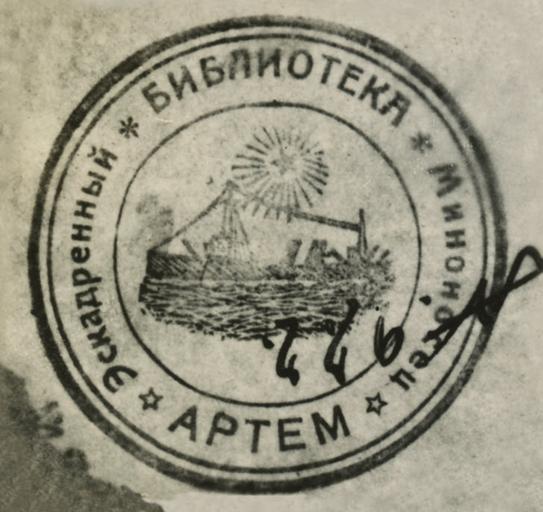MAKE A MEME
View Large Image

| View Original: | Library_of_the_Destroyer_Artem.jpg (728x686) | |||
| Download: | Original | Medium | Small | Thumb |
| Courtesy of: | www.flickr.com | More Like This | ||
| Keywords: hardware = epson expression 100 hardwareepsonexpression100 software = epson scan v2.20a an softwareepsonscanv220aan round circle monochrome This destroyer was originally built for the Baltic Fleet of the Russian Empire in 1916 and named “Azard.” It held this name until 1922 when it was renamed “Zinoviev” after Grigoriy Zinoviev, a prominent Soviet politician of the time. In 1928 it was renamed “Artem”, which is a common East Slavic given name. It mostly served as a convoy guard in the Baltic Sea in World War I and was involved in several conflicts with White and foreign naval forces supporting the Whites in the Russian Civil War. It underwent several renovations in the 1920s and and 1930s. It saw action in the Russo-Finnish war of 1939-1940 and in World War II. In the early months of Germany’s invasion of the Soviet Union, it participated in the defense of Riga, Tallinn, and the Estonian Moonsund archipelago as well as guarded convoys in the Baltic region. On August 27th, 1941, during the Soviet evacuation of Tallinn, it hit a mine and was sunk. This book stamp is from a book looted by the Nazis and sorted by Colonel Seymour Pomrenze, one of “the Monuments Men,” at the Offenbach Archival Depot. There are two scrapbooks of archival markings from the books sorted at the Offenbach Depot in the Seymour Pomrenze Collection held by the American Jewish Historical Society (Call number P-933) There is a finding aid for the collection here The digitized scrapbooks are available here and here. For more information on this project check the Center’s blog: 16thstreet.tumblr.com/tagged/Offenbach-Depot Dr. Mitch Fraas, Acting Director of the Digital Humanities Forum at the University of Pennsylvania Libraries' Special Collections Center is working on a similar project for the German book stamps based on NARA microfilm of the volumes the American Jewish Historical Society currently holds. See viewshare.org/views/mfraas/offenbach-bookplates/ The Center for Jewish History would like to acknowledge the following: The American Jewish Historical Society, who graciously allowed the use of their archival materials and digital content; Mitch Fraas, Acting Director of the Digital Humanities Forum at the University of Pennsylvania Libraries' Special Collections Center, for his data and technical assistance in this project; David Rosenberg, Senior Manager for Communications, and Melanie Meyers, Senior Reference Services Librarian for Special Collections, for managing and creating the digital map; as well as Reference Services Librarian Zachary Loeb and Reference Services Assistant Ilya Slavutskiy for their work on translating and mapping. For copyright information, click here This destroyer was originally built for the Baltic Fleet of the Russian Empire in 1916 and named “Azard.” It held this name until 1922 when it was renamed “Zinoviev” after Grigoriy Zinoviev, a prominent Soviet politician of the time. In 1928 it was renamed “Artem”, which is a common East Slavic given name. It mostly served as a convoy guard in the Baltic Sea in World War I and was involved in several conflicts with White and foreign naval forces supporting the Whites in the Russian Civil War. It underwent several renovations in the 1920s and and 1930s. It saw action in the Russo-Finnish war of 1939-1940 and in World War II. In the early months of Germany’s invasion of the Soviet Union, it participated in the defense of Riga, Tallinn, and the Estonian Moonsund archipelago as well as guarded convoys in the Baltic region. On August 27th, 1941, during the Soviet evacuation of Tallinn, it hit a mine and was sunk. This book stamp is from a book looted by the Nazis and sorted by Colonel Seymour Pomrenze, one of “the Monuments Men,” at the Offenbach Archival Depot. There are two scrapbooks of archival markings from the books sorted at the Offenbach Depot in the Seymour Pomrenze Collection held by the American Jewish Historical Society (Call number P-933) There is a finding aid for the collection here The digitized scrapbooks are available here and here. For more information on this project check the Center’s blog: 16thstreet.tumblr.com/tagged/Offenbach-Depot Dr. Mitch Fraas, Acting Director of the Digital Humanities Forum at the University of Pennsylvania Libraries' Special Collections Center is working on a similar project for the German book stamps based on NARA microfilm of the volumes the American Jewish Historical Society currently holds. See viewshare.org/views/mfraas/offenbach-bookplates/ The Center for Jewish History would like to acknowledge the following: The American Jewish Historical Society, who graciously allowed the use of their archival materials and digital content; Mitch Fraas, Acting Director of the Digital Humanities Forum at the University of Pennsylvania Libraries' Special Collections Center, for his data and technical assistance in this project; David Rosenberg, Senior Manager for Communications, and Melanie Meyers, Senior Reference Services Librarian for Special Collections, for managing and creating the digital map; as well as Reference Services Librarian Zachary Loeb and Reference Services Assistant Ilya Slavutskiy for their work on translating and mapping. For copyright information, click here | ||||